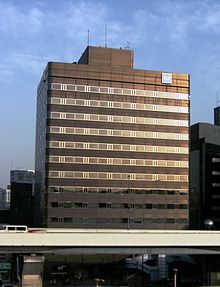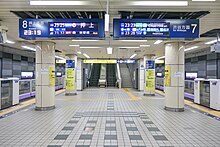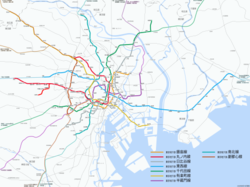Tokyo Metro
This article needs additional citations for verification. (May 2014) |
| Tokyo Metro | |||
|---|---|---|---|
 | |||
| Overview | |||
| Native name | 東京メトロ Tōkyō Metoro | ||
| Owner | Tokyo Metro Co., Ltd. | ||
| Locale | Greater Tokyo Area, Japan | ||
| Transit type | Rapid transit | ||
| Number of lines | 9[1] | ||
| Number of stations | 180[1] | ||
| Daily ridership | 6.84 million (FY2014)[2] | ||
| Website | Tokyo Metro | ||
| Operation | |||
| Began operation | 1927 as Tokyo Underground Railway (1941 as Teito Rapid Transit Authority; 2004 under current name) | ||
| Operator(s) | Tokyo Metro Co., Ltd. (private kabushiki gaisha owned by the Government of Japan (53.42%) and the Tokyo Metropolitan Government (46.58%)) | ||
| Number of vehicles | 2,773 cars (2012)[1] | ||
| Technical | |||
| System length | 195.1 km (121.2 mi)[1] | ||
| Track gauge | 1,067 mm (3 ft 6 in) 1,435 mm (4 ft 8+1⁄2 in) standard gauge for Ginza & Marunouchi lines | ||
| |||
The Tokyo Metro (東京メトロ, Tōkyō Metoro) is a major rapid transit system in Tokyo, Japan, operated by the Tokyo Metro Co. While it is not the only rapid transit system operating in Tokyo, it has the higher ridership among the two subway operators: in 2014, the Tokyo Metro had an average daily ridership of 6.84 million passengers, while the other system, the Toei Subway, had 2.85 million average daily rides.[2][3]
Organization


Tokyo Metro is operated by the Tokyo Metro Company, Ltd. (東京地下鉄株式会社, Tōkyō Chikatetsu kabushiki gaisha, Tokyo Subway Stock Company), a private joint-stock company jointly owned by the Government of Japan and the Tokyo Metropolitan Government.
The company, founded as a part of then-Prime Minister Junichiro Koizumi's policy of converting statutory corporations into joint-stock companies, replaced the Teito Rapid Transit Authority (帝都高速度交通営団, Teito Kōsokudo Kōtsū Eidan, lit. "Imperial Capital[a] Highspeed Transportation Management Foundation"), commonly known as Eidan or TRTA, on April 1, 2004.[4] TRTA was administered by the Ministry of Land, Infrastructure and Transport, and jointly funded by the national and metropolitan governments. It was formed in 1941 as a part-nationalization of the Tokyo Underground Railway and Tokyo Rapid Railway (now both form the Tokyo Metro Ginza Line), although its oldest lines date back to 1927 with the opening of the Tokyo Underground Railway the same year. Upon its establishment, the TRTA's legal form was used to be a "management foundation" (経営財団, keiei zaidan, abbreviated to and hence eidan (営団)), a form of entity established by the government of the wartime cabinet of the Empire of Japan with both public and private sector investments. Private sector investments to the TRTA were prohibited in 1951 when it was converted into an ordinary statutory corporation.
The other major subway operator is Tokyo Metropolitan Bureau of Transportation (Toei Subway) which is owned solely by the government of Tokyo. Tokyo Metro and Toei trains form completely separate networks, although Tokyo Metro Namboku Line and Toei Mita Line share the same track between Meguro Station and Shirokane-takanawa Station. Prepaid rail passes can freely interchange between the two networks (as well as other rail companies in the area), but fares are assessed separately for legs on each of these systems and regular ticket holders must purchase a second ticket, or a special transfer ticket, to change from a Toei line to a Tokyo Metro line and vice versa. Though, most Tokyo Metro (and Toei) line offer through service to lines outside of central Tokyo run by other carriers, and this can somewhat complicate the ticketing.
Much effort has been made to make the system accessible to non-Japanese speaking users:
- Many train stops are announced in both English and Japanese. Announcements also provide connecting line information.
- Ticket machines can switch between English and Japanese user interfaces.
- Train stations are signposted in English and Japanese (in kanji and hiragana). There are also numerous signs in Chinese (in simplified characters) and Korean.
- Train stations are now also consecutively numbered on each color-coded line, allowing even non-English speakers to be able to commute without necessarily knowing the name of the station. For example, Shinjuku Station on the Marunouchi Line is also signposted as M-08 with a red colored circle surrounding it; even if a commuter could not read the English or Japanese station names on signs or maps, they could simply look for the red line and then find the appropriately numbered station on said line. In addition, some trains have interior LCD displays which display station names in Japanese, English, Chinese, and Korean.
Many stations are also designed to help blind people as railings often have Braille at their base, and raised yellow rubber guide strips are used on flooring throughout the network.
Tokyo Metro stations began accepting contactless (RFID) Pasmo stored value cards in March 2007 to pay fares, and the JR East Suica system is also universally accepted. Both these passes also can be used on surrounding rail systems throughout the area and many rail lines in other areas of Japan. Due to the complexity of the fare systems in Japan, most riders converted to these cards very quickly even though there is an additional charge to issue it.
The Tokyo Metro is extremely punctual and has regular trains arriving 3 to 6 minutes apart most of the day and night. However, it does not run 24 hours a day. While through service with other companies complicates this somewhat, the last train generally starts at midnight and completes its service by 00:45, and the first train generally starts at 05:00.
Tokyo Metro indicated in its public share offering that it would cease line construction once the Fukutoshin Line was completed. That line was completed in March 2013 with the opening of the connection with the Tōkyū Tōyoko Line at Shibuya Station, allowing through service as far as Motomachi-Chūkagai Station in Yokohama. There are several lines such as the Hanzōmon Line that still have extensions in their official plans, and in the past, these plans have tended to happen, though often over several decades.
There are also some other rail project proposals in Tokyo which would involve large-scale tunneling projects, but these are unlikely to involve Tokyo Metro. The only proposal that has any suggestion of possible Tokyo Metro involvement is the prominent project proposed as a new Narita and Haneda Airport connection through a tunnel through central Tokyo to a new station adjacent to the existing Tokyo Station. This line is often described as a bypass of the current Toei Asakusa Line. It would link the Keisei Oshiage Line (with service to Narita Airport) to the Keikyu Main Line (with service to Haneda Airport) through Tokyo Station. The 400 billion yen project would be largely divided between the Tokyo metropolitan government and the Japanese central government (which is similar to the structure of Tokyo Metro) with the rail operator or operators paying the balance.[5] The suggestion of Tokyo Metro involvement comes mostly from its description as a bypass to the Asakusa Line which might imply it to be a subway line, but the principle proposal only includes one stop in Tokyo (at Tokyo Station). The principle justification of the proposal is to reduce connection time from Narita Airport to Tokyo Station by 13 minutes, and the design of the proposal makes this much more a high-speed rail project than a subway project (though, it would likely not be up to all of Japan's Shinkansen high-speed rail standards). Currently the only high-speed connection to the Narita Airport is the Keisei Skyliner which runs to Ueno, but there is ordinary train service between these airports using the Asakusa Line. The proposal would essentially allow the Skyliner to run to the more important Tokyo Station as well as establish a high-speed connection to the Haneda Airport.
Tokyo Metro also owns a number of commercial developments which mostly consist of shopping developments at major stations. It also owns the Subway Museum near Kasai Station on the Tokyo Metro Tōzai Line which opened on July 12, 1986, and features a few retired trains which once operated on the Ginza and Marunouchi Lines as well as a maintenance vehicle.
In 2017, Tokyo Metro opened its affiliate in Hanoi, Vietnam, which is set to be the service operator of Hanoi Metro.[6][7]
Fares
Pasmo and Suica are accepted on the Tokyo Metro, as well as on railway stations operated by other companies. Transfers between Tokyo Metro subway lines and Toei Subway lines are usually not free, but a discount is given when using the Pasmo or Suica cards to transfer between lines.
Traffic
According to the company, an average of 6.33 million people used the company's nine subway routes each day in 2009. The company made a profit of ¥63.5 billion in 2009.[8]
Lines
Altogether, the Tokyo Metro is made up of nine lines operating on 195.1 kilometers (121.2 mi) of route.[1]
List of Tokyo Metro lines
| Color | Sign | NumberN | Line | Japanese | Route | Stations | Length[1] | Train Length | First
Opened |
Last Opened | Daily ridership (2017)[9] |
Gauge | Current supply |
|---|---|---|---|---|---|---|---|---|---|---|---|---|---|
| orange | G | Line 3 | Ginza Line | 銀座線 | Shibuya to Asakusa | 19 | 14.3 km (8.9 mi) | 6 cars | 1927 | 1939 | 943,606 | 1,435 mm (4 ft 8+1⁄2 in) | 600 V DC, third rail |
| red | M | Line 4 | Marunouchi Line | 丸ノ内線 | Ogikubo to Ikebukuro | 25 | 24.2 km (15.0 mi) | 6 cars | 1954 | 1962 | 1,159,898 | ||
| Mb | Marunouchi Line Branch Line |
丸ノ内線分岐線 | Nakano-Sakaue to Hōnanchō | 4 | 3.2 km (2.0 mi) | 3 or 6 cars | 1962 | ||||||
| silver | H | Line 2 | Hibiya Line | 日比谷線 | Naka-Meguro to Kita-Senju | 22 | 20.3 km (12.6 mi) | 7 cars | 1961 | 2020 | 1,213,492 | 1,067 mm (3 ft 6 in) | 1,500 V DC, overhead supply |
| sky blue | T | Line 5 | Tōzai Line | 東西線 | Nakano to Nishi-Funabashi | 23 | 30.8 km (19.1 mi) | 10 cars | 1964 | 1969 | 1,642,378 | ||
| green | C | Line 9 | Chiyoda Line | 千代田線 | Yoyogi-Uehara to Kita-Ayase | 20 | 24.0 km (14.9 mi) | 10 cars | 1969 | 1978 | 1,447,730 | ||
| gold | Y | Line 8 | Yūrakuchō Line | 有楽町線 | Wakōshi to Shin-Kiba | 24 | 28.3 km (17.6 mi) | 10 cars | 1974 | 1988 | 1,124,478 | ||
| purple | Z | Line 11 | Hanzōmon Line | 半蔵門線 | Shibuya to Oshiage | 14 | 16.8 km (10.4 mi) | 10 cars | 1978 | 2003 | 1,006,682 | ||
| teal | N | Line 7 | Namboku Line | 南北線 | Meguro to Akabane-Iwabuchi | 19 | 21.3 km (13.2 mi) | 6 cars (to be expanded to 8 cars) | 1991 | 2000 | 522,736 | ||
| brown | F | Line 13 | Fukutoshin Line | 副都心線 | Wakōshi to Shibuya | 16 | 11.9 km (7.4 mi)A | 8 cars (local) 10 cars (local or express) |
1994 | 2008 | 362,654 | ||
| Total | 180 | 195.1 km (121.2 mi) | |||||||||||
N Note: Line numbers are for internal usage only and not listed on subway maps. A Note: Excluding the 8.3 km (5.2 mi) stretch between Wakoshi and Kotake-mukaihara shared with Yurakucho Line.[1]
Through services to other lines
| Line | Through Lines |
|---|---|
| HHibiya Line | TSTobu Skytree Line
TNTōbu Nikkō Line (Kita-Senju to Minami-Kurihashi and Tōbu-Dōbutsu-Kōen) |
| TTōzai Line | JBJR East Chūō-Sōbu Line (Chūō Main Line) (Nakano to Mitaka) |
| JBJR East Chūō-Sōbu Line (Sōbu Main Line) (Nishi-Funabashi to Tsudanuma) | |
| CChiyoda Line | OHOdakyu Odawara Line
OTOdakyu Tama Line (Yoyogi-Uehara to Karakida and Isehara) |
| JLJR East Jōban Line (Ayase to Toride) | |
| YYūrakuchō Line | TJTōbu Tōjō Line (Wakōshi to Ogawamachi)
|
| ZHanzōmon Line | DTTōkyū Den-en-toshi Line (Shibuya to Chūō-Rinkan) |
| TSTobu Skytree Line
TI Tobu Isesaki Line (Oshiage to Tōbu-Dōbutsu-Kōen, Minami-Kurihashi and Kuki) | |
| NNamboku Line | MGTokyu Meguro Line (Meguro to Hiyoshi) |
| SRSaitama Rapid Railway Line (Akabane-Iwabuchi to Urawa-Misono) | |
| FFukutoshin Line | Tōbu and Seibu line (same stations served as the Yūrakuchō Line) |
- Namboku Line shares tracks of the section from Meguro to Shirokane-Takanawa with Toei Mita Line, 2.3 km.
Stations

There are a total of 180 unique stations (i.e., counting stations served by multiple lines only once) on the Tokyo Metro network.[1][10] Most stations are located within the 23 special wards and fall inside the Yamanote Line rail loop — some wards such as Setagaya and Ōta have no stations (or only a limited number of stations), as rail service in these areas has historically been provided by the Toei Subway or any of the various major private railways (大手私鉄).
Major interchange stations, connecting three or more Tokyo Metro lines, include the following:
- Ginza
- Iidabashi
- Ikebukuro
- Kasumigaseki
- Kokkai-gijidō-mae / Tameike-Sannō
- Nagatachō / Akasaka-mitsuke
- Omotesandō
- Ōtemachi
- Shibuya
Other major stations provide additional connections to other railway operators such as the Toei Subway, JR East, and the various private railways, including (but not limited to) the following:
Depots
| Name | Location | Current assigned fleet | Former assigned fleet | Lines served |
|---|---|---|---|---|
| Ueno | Taitō, north of Ueno Station | 1000 | 01, (old) 2000, 1500, 1400, 1300, 100, 1200, 1100, (old) 1000 | Ginza |
| Shibuya | Shibuya, west of Shibuya Station | None (inspections only) | Ginza | |
| Nakano | Nakano, south of Nakano-Fujimichō Station | 2000, 02, 02-80 (branch line) | 300, 400, 500, 100 (branch line), (old) 2000 (branch line) | Marunouchi |
| Koishikawa | Bunkyō, between Myōgadani Station and Kōrakuen Station | None (inspection and renovation only) | Ginza, Marunouchi | |
| Senju | Arakawa, north of Minami-Senju Station | 13000 | 03, 3000 | Hibiya |
| Takenotsuka | Adachi, south of Takenotsuka Station | 13000 | 03, 3000 | Hibiya |
| Fukagawa | Kōtō, south of Tōyōchō Station | 05, 07, 15000 | 5000 | Tōzai |
| Gyōtoku | Ichikawa, south of Myōden Station | None (inspections only) | Tōzai | |
| Ayase | Adachi, north of Kita-Ayase Station | 16000, 05 (branch line) | 6000, 06, 5000 (branch line) | Chiyoda, Namboku, Yūrakuchō, Saitama Rapid |
| Wakō | Wakō, north of Wakōshi Station | 7000, 10000, 17000 (plan) | Fukutoshin, Yūrakuchō | |
| Shin-Kiba | Kōtō, southeast of Shin-Kiba Station | None (inspection and renovation only) | Chiyoda, Hanzōmon, Namboku, Tōzai, Yūrakuchō, and Fukutoshin | |
| Saginuma | Kawasaki, inside Saginuma Station | 08, 8000, 18000 (plan) | Hanzōmon | |
| Ōji | Kita, north of Ōji-Kamiya Station | 9000 | Namboku |
Rolling stock
As of 1 April 2016[update], Tokyo Metro operates a fleet of 2,728 electric multiple unit (EMU) vehicles, the largest fleet for a private railway operator in Japan.[11]
600 V third rail / 1,435 mm gauge lines


1,500 V overhead / 1,067 mm gauge lines


- 05 series – Tōzai Line
- 07 series – Tōzai Line
- 08 series – Hanzōmon Line
- 8000 series – Hanzōmon Line
- 9000 series – Namboku Line
- 10000 series – Yūrakuchō Line, Fukutoshin Line
- 13000 series – Hibiya Line[12]
- 15000 series – Tōzai Line
- 16000 series – Chiyoda Line
- 17000 series – Yūrakuchō Line, Fukutoshin Line
- 18000 series – Hanzōmon Line
Trains from other operators are also used on Tokyo Metro lines as a consequence of inter-running services.
Overcrowding

As is common with rail transport in Tokyo, Tokyo Metro trains are severely crowded during peak periods. During the morning peak period, platform attendants (oshiya) are sometimes needed to push riders and their belongings into train cars so that the doors can close. On some Tokyo Metro lines, the first or last car of a train is reserved for women during peak hours.
Network Map
See also
References
- ^ Teito (帝都) means the "capital of the Empire of Japan" (大日本帝国の首都, Dai Nippon Teikoku no shuto), that is, Tokyo
- ^ a b c d e f g h "Business Contents - Transportation Services - Business Situation". Tokyo Metro Co., Ltd. Retrieved 2014-06-07.
- ^ a b 営業状況 [Business Conditions] (in Japanese). 東京地下鉄株式会社 [Tokyo Metro Co., Ltd.] Retrieved 2015-11-24.
- ^ 東京都交通局ホーム - 経営情報 - 交通局の概要 - 都営地下鉄 [Tokyo Metropolitan Bureau of Transportation Home - Management Information - Overview of the Department of Transportation - Toei Subway] (in Japanese). 東京都交通局 [Tokyo Metropolitan Bureau of Transportation]. Retrieved 2015-11-24.
- ^ "「営団地下鉄」から「東京メトロ」へ" [From "Teito Rapid Transit Authority" to "Tokyo Metro"]. Tokyo Metro Online. 2006-07-08. Archived from the original on 16 May 2012. Retrieved 29 May 2022.
- ^ "Archived copy". Retrieved 2012-02-22.[dead link]
- ^ Vietnam Tokyo Metro set up to run Hanoi's urban railway
- ^ History of Tokyo Metro
- ^ Martin, Alex (August 3, 2010). "Ubiquitous Tokyo subways moving the daily masses". The Japan Times. p. 3.
- ^ Tokyo Metro station ridership in 2017 Train Media (sourced from Tokyo Metro) Retrieved May 28, 2018.
- ^ 各駅の乗降人員ランキング [Table of Traffic Performance by Station] (in Japanese). 東京地下鉄株式会社 [Tokyo Metro Co., Ltd.] Retrieved 2014-06-07.
- ^ 私鉄車両編成表 2016 [Private Railway Rolling Stock Formations - 2016] (in Japanese). Japan: Kotsu Shimbunsha. 25 July 2016. p. 213. ISBN 978-4-330-70116-5.
External links
- Tokyo Metro (in English)
- Tokyo Metro Subway Map (PDF)


